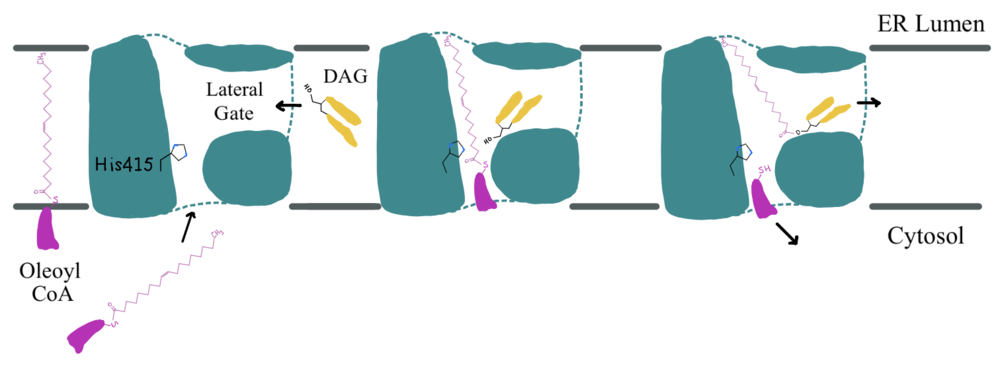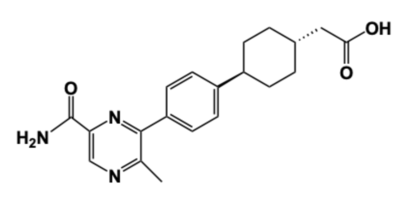User:Betsy Johns/Sandbox 1
From Proteopedia
(Difference between revisions)
| Line 49: | Line 49: | ||
[[Image:DGAT_INHIBITOR.png|400 px|right|thumb|'''Figure 4: DGAT Inhibitor AZD7687''' Shown is the structure of AZD7687, a known inhibitor of DGAT.]] | [[Image:DGAT_INHIBITOR.png|400 px|right|thumb|'''Figure 4: DGAT Inhibitor AZD7687''' Shown is the structure of AZD7687, a known inhibitor of DGAT.]] | ||
| - | Obesity and nonalcoholic fatty liver disease ([https://www.mayoclinic.org/diseases-conditions/nonalcoholic-fatty-liver-disease/symptoms-causes/syc-20354567 NAFLD]) result from an accumulation of triglycerides within the body. Recently, DGAT has become a therapeutic target for obesity and nonalcoholic fatty liver disease in order to reduce triglyceride storage within the body. Different inhibitors have been created, such as AstraZeneca’s direct inhibitor [https://www.apexbt.com/azd7687.html AZD7687], shown in Figure 4 <ref name="Denison">PMID: 24118885</ref>. AZD7687 has an EC50 value 0.44 µmol/L, showing that it binds with high affinity at a low concentration of DGAT. However, while triglyceride accumulation decreased, negative side effects did occur, such as diarrhea and other adverse GI symptoms. | + | Obesity and nonalcoholic fatty liver disease ([https://www.mayoclinic.org/diseases-conditions/nonalcoholic-fatty-liver-disease/symptoms-causes/syc-20354567 NAFLD]) result from an accumulation of triglycerides within the body. Recently, DGAT has become a therapeutic target for obesity and nonalcoholic fatty liver disease in order to reduce triglyceride storage within the body. Different inhibitors have been created, such as AstraZeneca’s direct inhibitor [https://www.apexbt.com/azd7687.html AZD7687], shown in Figure 4 <ref name="Denison">PMID: 24118885</ref>. AZD7687 has an EC50 value 0.44 µmol/L, showing that it binds with high affinity at a low concentration of DGAT <ref name="Denison">PMID: 24118885</ref>. However, while triglyceride accumulation decreased, negative side effects did occur, such as diarrhea and other adverse GI symptoms <ref name="Denison">PMID: 24118885</ref>. |
Additionally, congenital protein-losing enteropathy ([https://www.uptodate.com/contents/protein-losing-gastroenteropathy PLE]) is linked to DGAT mutations. PLE is a GI disorder that causes malabsorption of fat and a deficiency in fat-soluble vitamins. Patients in a congenital PLE case study exhibited a homozygous missense Leu295Pro mutation within the MBOAT core of their DGAT enzymes <ref name="Stephen">PMID: 26883093</ref>. <scene name='87/877512/Mutation/4'>Leu295</scene> is located within the MBOAT core active site on TM5. While the Leu295 is not near the catalytic residues His415 and Glu416, the <scene name='87/877512/Cple/3'>Leu295Pro</scene> mutation will disrupt the overall active site. Proline is an alpha helix breaker because it causes steric hindrance within the backbone of the helix turn. It is hypothesized that this mutation breaks this helix in the MBOAT core and greatly reduces its enzymatic activity and ability to make triacylglycerides. Without proper DGAT function to produce triacylglycerides, there is a decrease in albumin, which is a protein that helps prevent fluid from leaking out of the liver and blood vessels. This decrease in albumin then leads to decreased efficiency in nutrient transport and fat absorption. | Additionally, congenital protein-losing enteropathy ([https://www.uptodate.com/contents/protein-losing-gastroenteropathy PLE]) is linked to DGAT mutations. PLE is a GI disorder that causes malabsorption of fat and a deficiency in fat-soluble vitamins. Patients in a congenital PLE case study exhibited a homozygous missense Leu295Pro mutation within the MBOAT core of their DGAT enzymes <ref name="Stephen">PMID: 26883093</ref>. <scene name='87/877512/Mutation/4'>Leu295</scene> is located within the MBOAT core active site on TM5. While the Leu295 is not near the catalytic residues His415 and Glu416, the <scene name='87/877512/Cple/3'>Leu295Pro</scene> mutation will disrupt the overall active site. Proline is an alpha helix breaker because it causes steric hindrance within the backbone of the helix turn. It is hypothesized that this mutation breaks this helix in the MBOAT core and greatly reduces its enzymatic activity and ability to make triacylglycerides. Without proper DGAT function to produce triacylglycerides, there is a decrease in albumin, which is a protein that helps prevent fluid from leaking out of the liver and blood vessels. This decrease in albumin then leads to decreased efficiency in nutrient transport and fat absorption. | ||
Revision as of 15:20, 25 April 2021
Diacylglycerol acyltransferase, DGAT, synthesizes triacylglycerides
| |||||||||||
References
- ↑ 1.0 1.1 1.2 1.3 Wang L, Qian H, Nian Y, Han Y, Ren Z, Zhang H, Hu L, Prasad BVV, Laganowsky A, Yan N, Zhou M. Structure and mechanism of human diacylglycerol O-acyltransferase 1. Nature. 2020 May;581(7808):329-332. doi: 10.1038/s41586-020-2280-2. Epub 2020 May, 13. PMID:32433610 doi:http://dx.doi.org/10.1038/s41586-020-2280-2
- ↑ 2.0 2.1 2.2 Sui X, Wang K, Gluchowski NL, Elliott SD, Liao M, Walther TC, Farese RV Jr. Structure and catalytic mechanism of a human triacylglycerol-synthesis enzyme. Nature. 2020 May;581(7808):323-328. doi: 10.1038/s41586-020-2289-6. Epub 2020 May, 13. PMID:32433611 doi:http://dx.doi.org/10.1038/s41586-020-2289-6
- ↑ 3.0 3.1 3.2 3.3 Ma D, Wang Z, Merrikh CN, Lang KS, Lu P, Li X, Merrikh H, Rao Z, Xu W. Crystal structure of a membrane-bound O-acyltransferase. Nature. 2018 Oct;562(7726):286-290. doi: 10.1038/s41586-018-0568-2. Epub 2018 Oct, 3. PMID:30283133 doi:http://dx.doi.org/10.1038/s41586-018-0568-2
- ↑ 4.0 4.1 4.2 4.3 Denison H, Nilsson C, Lofgren L, Himmelmann A, Martensson G, Knutsson M, Al-Shurbaji A, Tornqvist H, Eriksson JW. Diacylglycerol acyltransferase 1 inhibition with AZD7687 alters lipid handling and hormone secretion in the gut with intolerable side effects: a randomized clinical trial. Diabetes Obes Metab. 2014 Apr;16(4):334-43. doi: 10.1111/dom.12221. Epub 2013 Oct, 31. PMID:24118885 doi:http://dx.doi.org/10.1111/dom.12221
- ↑ 5.0 5.1 Stephen J, Vilboux T, Haberman Y, Pri-Chen H, Pode-Shakked B, Mazaheri S, Marek-Yagel D, Barel O, Di Segni A, Eyal E, Hout-Siloni G, Lahad A, Shalem T, Rechavi G, Malicdan MC, Weiss B, Gahl WA, Anikster Y. Congenital protein losing enteropathy: an inborn error of lipid metabolism due to DGAT1 mutations. Eur J Hum Genet. 2016 Aug;24(9):1268-73. doi: 10.1038/ejhg.2016.5. Epub 2016 Feb , 17. PMID:26883093 doi:http://dx.doi.org/10.1038/ejhg.2016.5
Student Contributors
- Betsy Johns
- Elise Wang
- Tyler Bihasa




